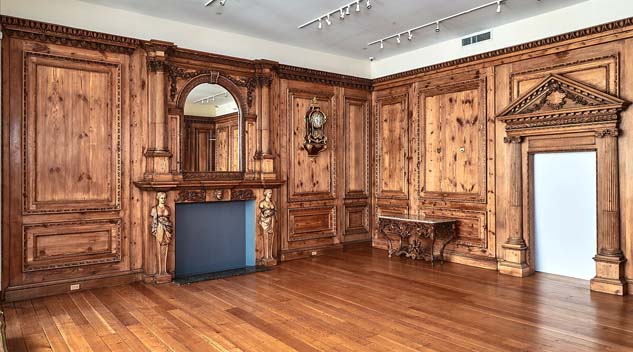#Dalva #Bros #Legacy #Lives #Doyles #TwoDay #Event #Antiques #Arts #Weekly
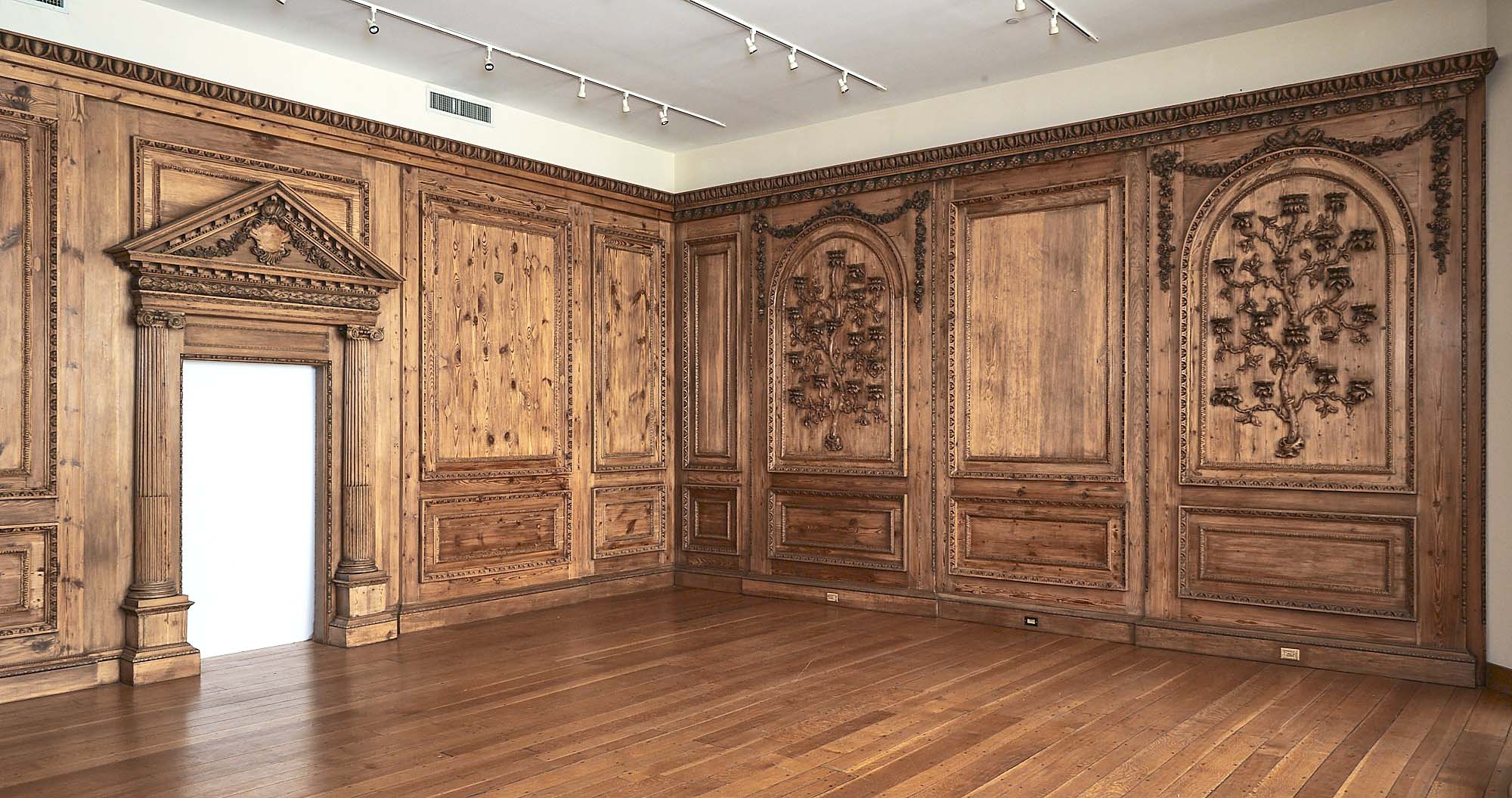
Leading the collection was an Eighteenth Century English George II carved pine paneled room with a fireplace mantel, wall shelves and a column doorway. Each panel was 13 feet high and altogether the room sold for $64,000 ($60/80,000).
Review by Carly Timpson
NEW YORK CITY — For nearly a century, New York City-based Dalva Brothers was a leading provider of Eighteenth Century French and Continental furniture and decorative arts. Items from their showroom can be found in private collections and prestigious institutions around the world, including the J. Paul Getty Museum, the Metropolitan Museum of Art, the Louvre and the Palace of Versailles. On June 4 and 6, Doyle Auctioneers & Appraisers auctioned a total of 533 lots of primarily furniture and decorative arts, all from The Dalva Brothers Collection. Combined, the two days of sales amassed $1,261,444 with a sell-through rate of 86 percent.
With notable results driven by international competition, the first session of sales presented furniture, decorative arts and Old Masters from The Dalva Brothers Collection. Successfully hammering down 93 percent of the lots, the first day realized a total of $1,106,980. Included among the selection of 382 lots were several period panel rooms, which had been installed by Dalva Brothers in their townhouse galleries. Earning the highest price across both days of sales was an Eighteenth Century George II carved pine paneled room of grand proportions. Complete with a fireplace mantel, wall shelves and a carved column and pediment doorway, each panel was 13 feet high. Several panels included carved trees in arched frames rather than the more common flat rectangular pattern. The mantel, carved with robed female figures standing on either side and a radiant face, flanked by scrolling foliate details centered above, measured 66 inches high by 113 inches wide and was 19 inches deep. Altogether the room, comprising of elements from three rooms, sold within its estimate range for $64,000.
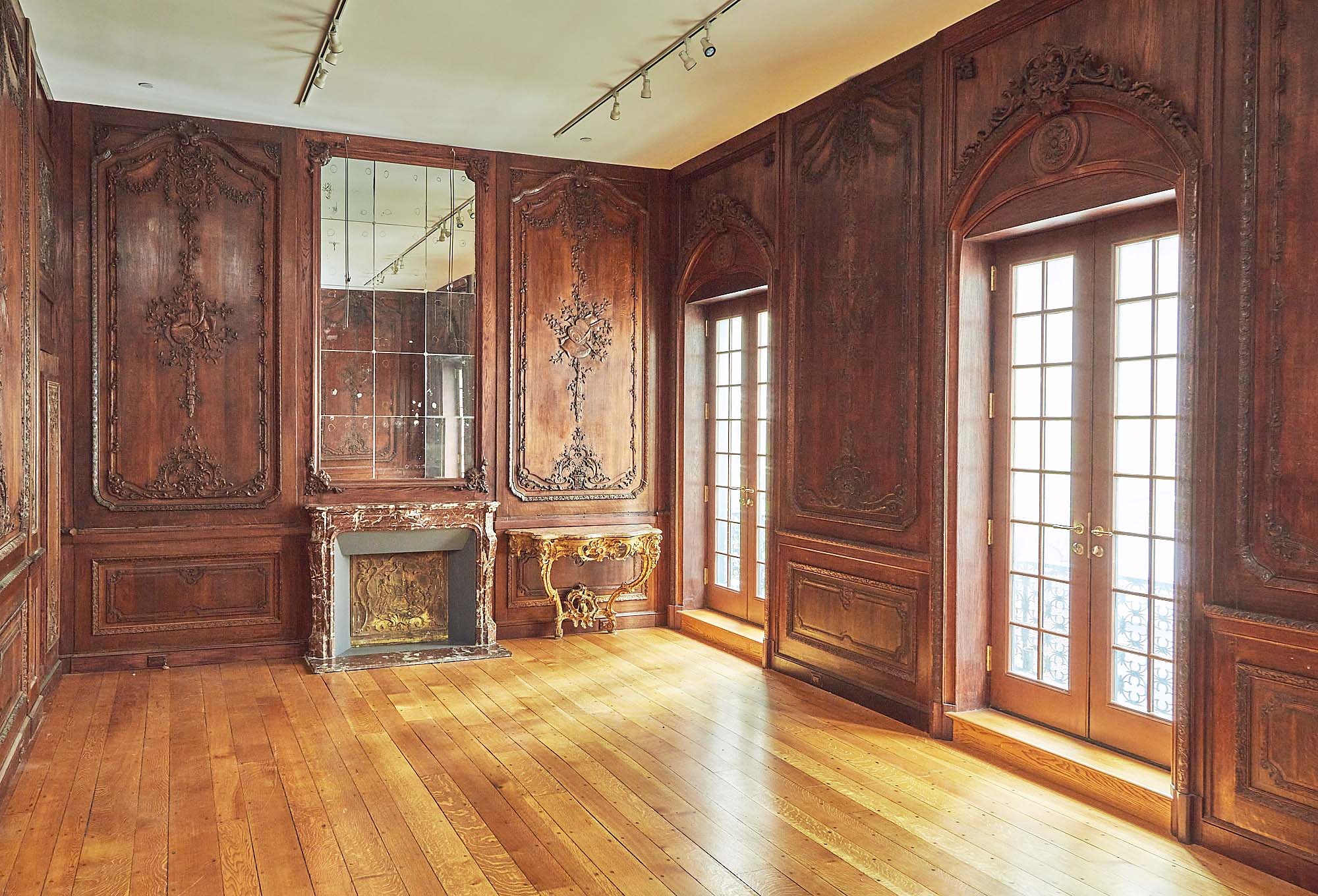
These Eighteenth Century-style French oak boiserie panels were from the Nineteenth Century and included side walls, an arched window wall and a marble mantel; the room sold for $44,800 ($40/60,000).
A Nineteenth Century French oak boiserie room, delicately carved with foliate designs in the Eighteenth Century manner was the second-highest selling lot. This room, with high arched windows and a marble mantel, went out at $44,800. Each panel’s carved foliate details framed one of several classical instruments found throughout the room. Another room, this one with Italian Neoclassical style mauve and green painted paneling, also included a white Carrara marble mantel. This room was once property of Edulji Dinsha’s New York estate. Carved with mask pendants, urns and flowers, the room found a buyer for $19,200.
Leading the furniture category was a Régence limewood console table that achieved $28,800. Designed by Josef Effner and carved by Johann-Adam Pichler, both Germans who had been sent to study in Paris from 1709 to 1715 by the Bavarian royal court, the table’s frieze featured scrolls, swags and dragons centered on a female mascaron. The four cabriole legs were headed by blowing putti, likely representative of Zephyrus, the Greek god of the wind, and joined by an X-form stretcher, which had a sculpture of two putti in the center. Similar tables are in several German museums, the Getty Museum and the Boston Museum of Fine Arts. This one had a later shaped verte compagne marble top that bore a paper label reading, “88 / M. Arnal de Curel / Vignan.” The “superbly carved” table had provenance to Arnal de Curel, Archbishop of Monaco (1903-1915), and was most likely from the Hôtel Arnal-de Curel in le Vigan; it was later sold in the 1981 estate auction of Mrs K. Peto Bennett at Christie’s, London, again auctioned by Christie’s in 1987 and last sold by Sotheby’s, London in 2006.

With a frame of scrolling vines, this 77-inch-by-45-inch Louis XV giltwood mirror, Eighteenth Century, enticed bidders who took it to $21,760 ($3/5,000).
At $21,760 was a tall Louis XV carved giltwood mirror, which had a high estimate of just $5,000. The rectangular Eighteenth Century mirror was framed with scrolling vines and topped with a shaped crest that centered two birds, facing inward. Other Louis XV material included a French tulipwood chinoiserie decorated lady’s desk. The black lacquer desk had four interior drawers and various shelving compartments. It was signed “Rubestuck,” likely François Rübestück (1722-1785) and, achieving $16,640, it finished more than 20 times its high estimate.
A pair of Louis XV facing asymmetrical giltwood console tables with white marble tops sold together for $12,800 and a Louis XV/XVI transitional gilt-bronze mounted kingwood inlaid commode attributed to French cabinetmaker, Charles Topino, sold for $21,760. While this three-drawer, two-door commode measured 35 by 51 inches and had a Breche d’Alep marble top, several smaller ones with the same configuration are known to exist.
An Iberian, possibly Catalan, gilded carved wooden figural group that was once in the collection of the Carnegie Museum of Art, Pittsburgh, crossed the block for $17,920. The Sixteenth Century carving depicted Christ preaching in the temple, seated at the top of stairs with eight other distinct figures surrounding him on the lower level and had remnants of black, red and green paint in addition to the gilding.
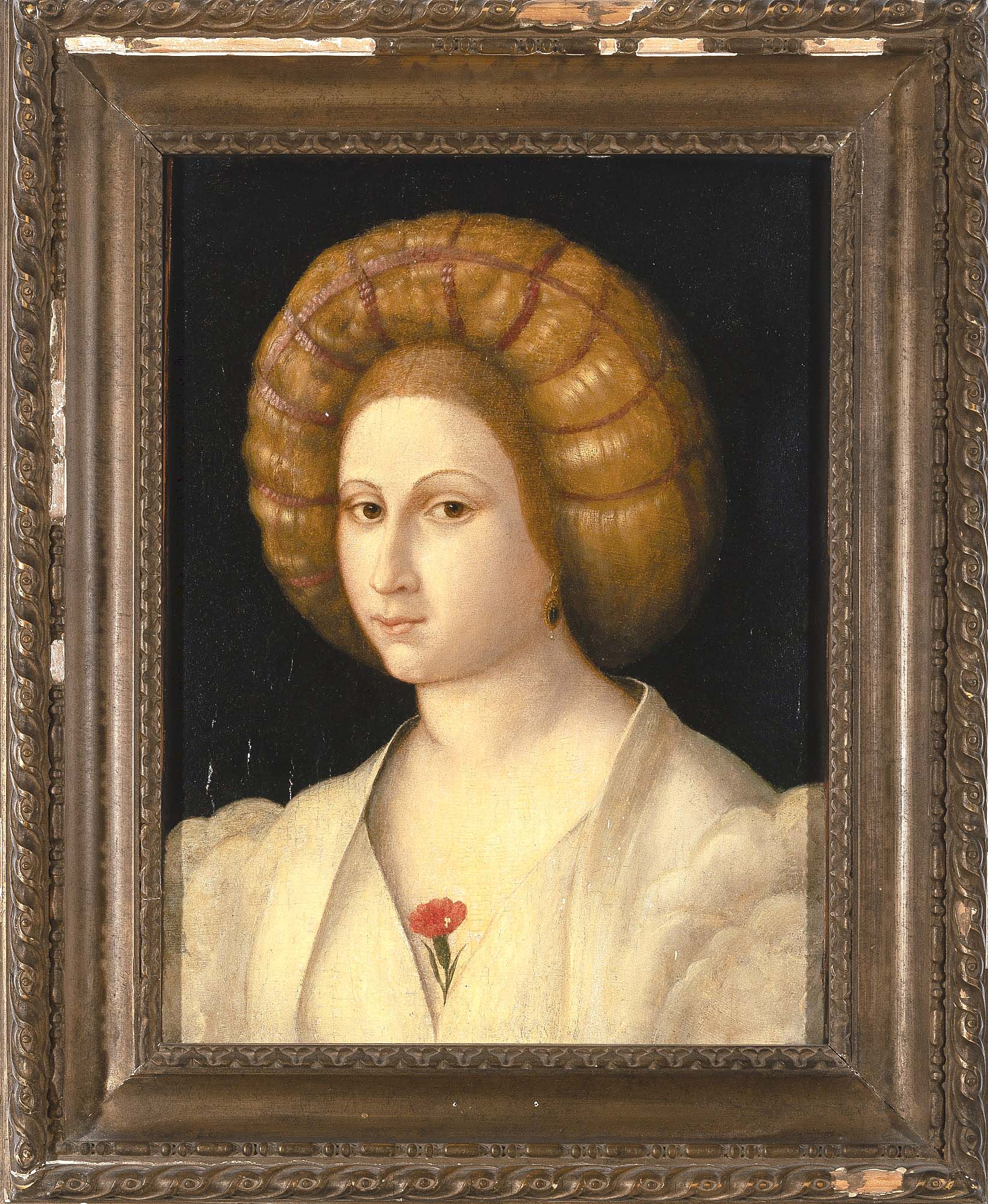
“Portrait of a Lady Wearing an Elaborate Headdress,” a Sixteenth Century Venetian School oil on panel work, 27½ by 22½ inches framed, went out at $12,160 ($5/9,000).
Another Sixteenth Century artwork was a Venetian School oil on panel cataloged as “Portrait of a Lady Wearing an Elaborate Headdress.” Formerly in the collection of William and Edith Wilson, the painting was thought to be by Giovanni Bellini (Italian, 1430-1516) and Dalva Brothers had several certificates supporting the opinion. Art historian Raimond van Marle discussed the work in his The Development of Italian Schools of Painting, Volume 17 (M. Nijhoff, 1923). The portrait traded hands for $12,160.
At 43½ inches high, an Italian-made vase of granito rosso d’egitto (Red Granite of Egypt) from the quarries of Aswan, Egypt, found a buyer for $12,800. The large lidded and dual-handled amphora had provenance to Henry DuPont.
Stained glass made an appearance among top lots with two French Romanesque panels achieving $11,520 against a high estimate of just $1,200. The panel fragments were believed to be from Église Saint-Malo, a Catholic church in Dinan, France. The stained glass panels were acquired from the cathedral by Mr and Mrs Junius P. Morgan, the parents of financier John Pierpont “J.P.” Morgan. The two sections were part of a larger depiction of “The Flight Into Egypt” and were made mostly during the Twelfth Century.
The second day was dedicated to porcelain from the Dalva Brothers Collection and included 151 lots from makers such as Sèvres, Vincennes, Meissen and others. This dedicated porcelain session realized $154,464 and had a 73 percent sell-through rate. After the sale, Doyle furniture and fine arts specialist and head of sale for both Dalva Brothers auctions, Sal Trupiano, shared that 35 percent of the porcelain lots were won by international bidders.
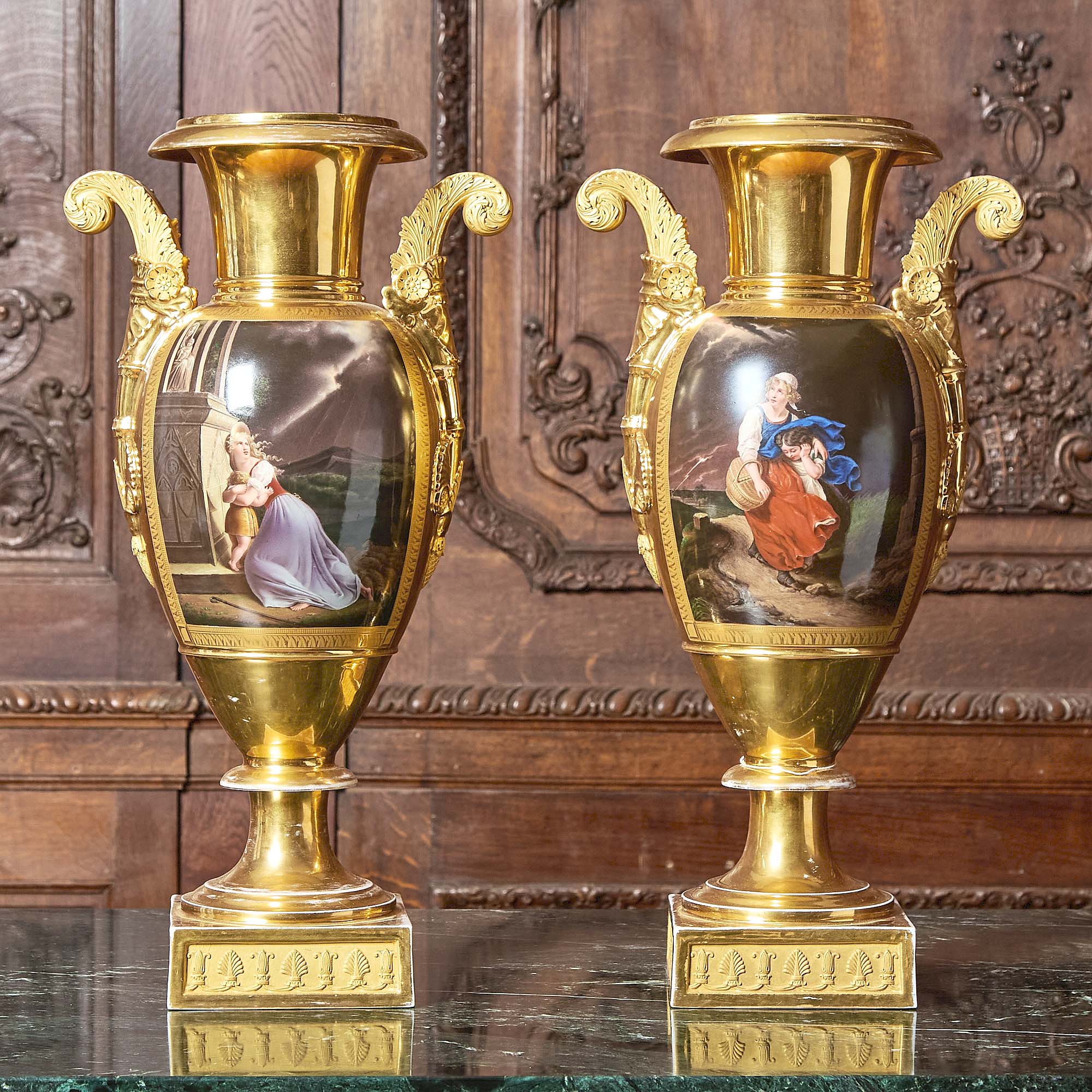
At $5,120, a pair of Darte Frères, Paris, gold-ground acanthus-scroll handled vases, circa 1810, 21½ inches tall by 11 inches wide by 7 inches deep, led the porcelain collection ($6/8,000).
At the top of the sale was a pair of gold-ground Darte Frères Parisian acanthus-scroll handled baluster form vases. The body of each vase was painted with a stormy outdoor scene of a young woman sheltering children, in the manner of Alexandre-Évariste Fragonard (French, 1780-1850). Opposite the paintings, the back side of the vases were etched with images of putti, sheaves of wheat, lyres and anthemia garlands. Together, the two vases were bid to $5,120.
Another pair of vases, these much smaller, crossed the block for $4,160. At just 2½ inches high, the miniature Vincennes vases, or Vase Parseval, were made circa 1753, were both painted with two flowers — one on each main face — and had gilded accents on the rim and foot. Similar examples are in the Musée de Sèvres and featured in a Grand Palais, Paris exhibition catalog, Porcelaines de Vincennes, Les Origines de Sèvres (Éditions des Musées Nationaux, 1977).
A circa 1779 Sèvres hard-paste porcelain café-au-lait cup and saucer (goblet litron), detailed with gilt and silvered birds and flowering landscapes within Meissen style Gitterwerk rims, exceeded estimates to make $4,800. Initials on the underside of both pieces indicate that they were done by gilder Henri-Martin Prévost l’aîné (active 1757-1797) and painter/gilder Descambos (active 1776-1778).

These basket-form salts, Sèvres or Vincennes, mid to late Eighteenth Century, were marked with an interlaced “LL” monogram and François Baudoin’s “BD” gilder’s mark, 3-5/8 inches long each, went out at $4,480 ($600/800).
Though Doyle specialists could not definitively say whether a pair of mid-Eighteenth Century divided basket-form salts were made under the Sèvres or Vincennes name, bidders were intrigued and took the set to $4,480 against an $800 high estimate. The small white baskets had twisted handles and gilded accents to look like the gold was woven into the rims. A gilders mark “BD” for François Baudoin, père (active at Vincennes and Sèvres 1750-1800), was included on each.
Prices quoted include the buyer’s premium as reported by the auction house. On July 18, Doyle will conduct an auction of furniture, decorative arts and more. For information, 212-427-2730 or www.doyle.com.

